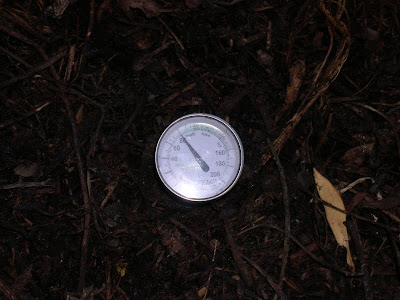I recently took another step on my journey into compost madness. I bought a NatureMill automatic composter.


The NatureMill automatic composter is an in-vessel composter for household food waste that automatically turns and aerates the compost. It is insulated, so it attains high temperatures. The high temperatures, mixing, and aeration create an optimized composting environment where the decomposition is supposed to be accelerated.
The NatureMill is supposed to be able to process up to about five pounds of food waste a day, or about 120 pounds per month (which is a lot more than we generate at this house). The NatureMill is also able to process things that are not appropriate for your outside compost bin or a worm bin. It can process cooked food, meat, cheese, and bread. There is a special model that is designed to handle pet waste as well. Those kinds of items are generally not appropriate for other kinds of home composting because of nuisances like smells, pests, or pathogens.
Because of the temperatures and aeration, the decomposition is supposed to occur very rapidly, and the food waste is not supposed to have time to get smelly. It also has an activated charcoal air filter to remove any residual odors. Because it is fully self contained, it is not supposed to attract any kinds of pests --- no rodents or flies. And because of the high temperatures, it is supposed to pasteurize pathogens.
At first glance, it seems like a silly high-tech solution to a process that can occur naturally with no technology whatsoever. But the fact is that even though “compost happens,” unless you put some knowledge and effort into controlling the environment and method of composting, you can invite some problems, especially when dealing with food waste. Yard waste is generally problem free, but I wanted a problem-free way to deal with the kitchen waste.
I had decided some time ago that I mostly did not want to process food waste through the regular outdoor Biostack bin. We have had rodents around the neighborhood at different times, and I did not want to be the cause of any of those problems. I don’t think rats or mice were feeding out of my bin or nesting in there, but I didn’t want to create any possibility of that happening. If you have been reading the blog, you know I did feed Fertilemyrtle Rottenpile a lot of food waste, but that was mostly for demonstration purposes. And whenever I did put food waste in the outdoor bin, I buried it deep and made sure to check it and aerate it frequently until it was completely decomposed. That can be a bit of a hassle.
I also have a worm bin that works for composting food waste. But the worm bin has its own set of hassles too. When everything is working perfectly, it can handle a maximum of about a half pound of food waste per day, but I was never able to get mine to actually accept that much. So it really didn’t process much waste. And when I did “overfeed” it, it tended to get fruit flies. Personally, I can deal with fruit flies and worms, but it’s not something most people would be interested in messing with.
If the NatureMill works as described, most of those problems should go away. I’ll be able to just open the lid of the NatureMill and dump in all the kitchen scraps, without having to pick through and pull out inappropriate ingredients the way I used to do with the worm bin. I’ll be able to put it
all in, up to five pounds a day, without worrying whether I have “overfed” it the way I used to do with the worm bin. And because it is less of a hassle, and it sits right in the garage, outside the kitchen door, I’m more likely to actually take the food waste out instead of letting it “pre-compost” on the kitchen counter, a practice that Kathy never really seemed to appreciate very much. In fact, Kathy might actually take out the kitchen waste herself, which is not something she liked to do when it had to be buried in the Biostack or fed to the worms.
I think the NatureMill is going to be a bit like the gas barbeque I got a few years ago to replace the beloved charcoal Weber Kettle. I loved the old Weber and the authenticity of cooking over real burning charcoal, with real wood smoke, and real fire. But there were some inconveniences to it, and when I finally got the gas grill, I loved it too. I loved being able to turn the knob, hit a button and then just grill, rather than having to start a fire a half hour beforehand. I loved being able to adjust the temperature with a knob. I loved being able to cook something for over an hour without having to add more charcoal. A gas grill brings a lot of unnecessary technology to grilling for the sake of convenience, and I think the NatureMill is basically the same concept. I’m definitely going to keep the Biostack for yard waste, and I’ll probably keep the worm bin for the sake of harvesting worm castings. But, assuming everything works as described, I think I’m going to like the NatureMill for the convenience.
I’ll post more information about my experiences with the amazing NatureMill. Until then, for more info, you can check out the NatureMill website:
http://www.naturemill.com/.


















































